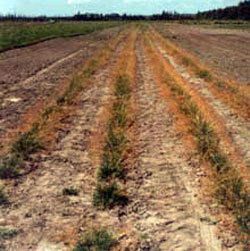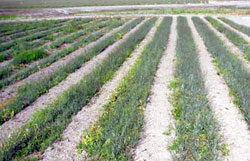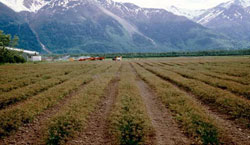| Chapter 5: Cultivars and Species for Use in Alaska Commercially Available Species and Cultivars Bluegrass, Alpine ‘Gruening’ alpine bluegrass was released by the Alaska Plant Materials Center (PMC) in 1986 (Wright, 1991c). The species is widely adapted throughout Alaska. As the name implies, the species is adapted to high elevation areas. It also performs well on sites drier than those tolerated by Kentucky bluegrass. Seed availability is limited. Before this cultivar is included in a planting plan, the availability of the seed should be researched. 
Figure 96: ‘Gruening’ alpine bluegrass
Bluegrass, Glaucous ‘Tundra’ glaucous bluegrass was originally collected in Arctic Alaska. The cultivar was released by the University of Alaska Agricultural Experiment Station for revegetation in extreme northern areas with severe environmental conditions (Mitchell, 1979). 
Figure 95: ‘Tundra’ glaucous bluegrass
Bluegrass, Kentucky ‘Merion’ Kentucky bluegrass was released in 1947 by the USDA Plant Service Research Division, ARS and the U.S. Golf Association Green Section. The cultivar is more adapted to close mowing than any other Kentucky bluegrass (USDA, 1972). Merion is often used in lawn mixes in Alaska. ‘Merion’ looks like ‘Nugget’.
Bluegrass, Kentucky ‘Nugget’ Kentucky bluegrass was released and developed by the University of Alaska Experiment Station in 1966. The source of this cultivar was a single plant collection made in 1957 at Hope, Alaska. ‘Nugget’ has outstanding winter survival (USDA, 1972) and is used extensively in Alaska for turf and lawns. 
Figure 38: ‘Nugget’ Kentucky bluegrass is no longer recommended for standard revegetation. Its use should be limited to landscaping projects in urban or residential areas. This field is a foundation seed production field at the PMC. The other two cultivars of Kentucky bluegrass resemble ‘Nugget’.
Bluegrass, Kentucky ‘Park’ Kentucky bluegrass was developed by the Minnesota Agricultural Experiment Station in 1957 (USDA, 1972). Hardiness of this cultivar is not as good as ‘Nugget’ in extreme northern areas of Alaska. However, it is still used in volume in Alaska. Like ‘Nugget’, its use tends to be limited to landscape and lawns. ‘Park’ looks like ‘Nugget’.
|
